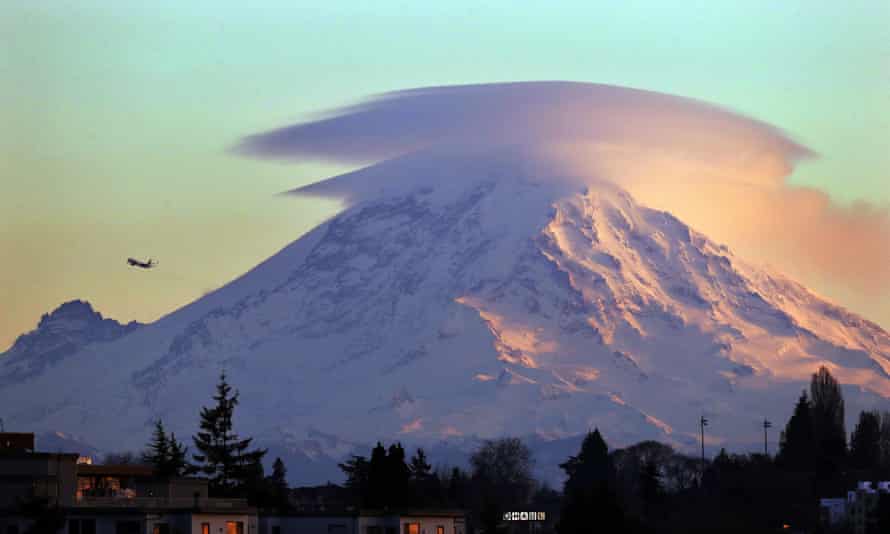The funeral was a suitably solemn affair. The small casket was placed on a table covered in a black drape, a maudlin yet defiant speech quoted a Dylan Thomas poem, a moment’s silence was held.
Inside the casket, however, was not a body, but a vial of meltwater from Clark glacier in Oregon, once an imposing body of ice but now a shrivelled remnant.
The funeral, a stunt held by worried glacier researchers on the steps of the state capitol in Salem, illustrated how the climate crisis is rapidly gnawing away at the majestic icepacks that used to throng the mountains of the northwestern US, potentially posing a threat to the region’s water supplies.
“There is just this immense sadness because we all knew it was going to be bad, but didn’t think it would be this bad,” said Anders Carlson, president of the Oregon Glacier Institute, who read the eulogy for Clark glacier at the “funeral” in October.
Clark glacier is, or was, found if you took a moderately strenuous hike amid the Cascade mountains, a range that stretches from British Columbia in Canada down to the northern reaches of California.
Once spanning about 46 football pitches in size, the Clark glacier is now about three football pitches in area, or what Carlson calls a “stagnant scrap of ice”.

“It’s like a rotting carcass of its former self,” said Carlson. Glaciers move via gravity under their own vast weight, but once they have lost a certain amount of volume, they become dormant patches of ice. Other nearby glaciers found on the three sisters, a chain of volcanic peaks, and Mount Hood have similarly “died” in this way.
“You go back through old photographs and glaciers have disappeared just in the last 20 years – it’s really dramatic,” said Carlson, who has calculated that at least a third of the state’s glaciers named by the US government in the 1950s are now gone.
Among their other benefits, the meltwater from glaciers each spring feeds streams and rivers that supply a water source for apple and pear orchards, vineyards and even some drinking water for towns situated in the shadows of the mountains.
Researchers have estimated that river volumes in the late summer could drop by 80% by the end of the century due to decreases in glacier and snow melt. These huge losses raise tough questions over how to replace the water.
“These glaciers are not just nice to look at – they are our water towers, where we store our water,” said Carlson.
“Places like Hood River and Eugene are drinking and growing crops with water from glaciers. If you like Oregon wine, the chances are it was grown with glacier water. If you lose that, it’s not going to be a pretty picture. You either try to get groundwater or build new dams, which is not popular with anyone.”
The decline of glaciers is part of a broader trend that has seen vast bodies of ice wither away from the Himalayas to Switzerland as global temperatures climb. The glaciers of America’s Pacific north-west aren’t as well known as those overseas, but they play an important role in the local environment and are suffering stunning losses.
Since the mock funeral, researchers have found that the Cascades are particularly vulnerable to the melting of glaciers, which can cause maladies ranging from increased wildfire risk to the loss of species such as steelhead trout that rely on the frigid cold of glacier-fed streams. In the longer term, the glaciers of the American west face almost complete obliteration.
“The glaciers in the western US continue to shrink and will largely disappear by the end of the century,” said Andrew Fountain, a geologist at Portland State University who has submitted new research that found the glaciers of the Olympic Mountains, in the state of Washington, will probably vanish by 2070.
“You might get icy remnants on the peaks of tall mountains like Mount Rainier or Mount Baker, but they will be pretty small. Rising temperatures are doing this, without a doubt.”
Beyond drastically cutting planet-warming emissions, there is little that can be done to salvage the glaciers, a sobering reality for those who have long hiked and climbed the peaks of the US north-west.
“It’s really hard to stop the decline,” said Carlson. “People don’t realise we are a glacierised country – we rely upon them, like the Swiss and Norwegians do. They are important and we need them.”